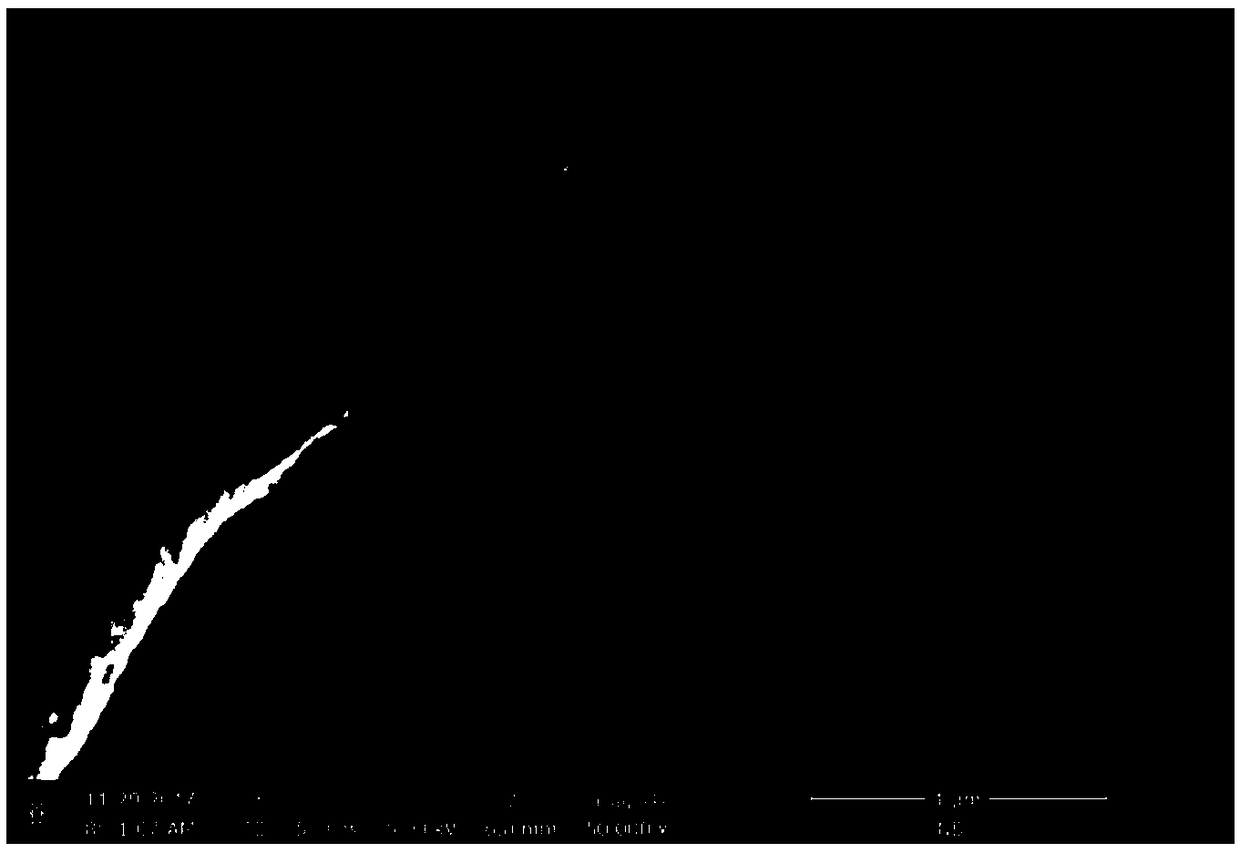Preparation method of LaTi<21>O<38>CoTi<3>Mn<3>O<4> composite nanowires
A nanowire and composite technology, applied in the field of material chemistry, can solve the problems of limiting discharge capacity and rate performance, poor electrical conductivity, etc., and achieve the effect of uniform particle size and high stability
- Summary
- Abstract
- Description
- Claims
- Application Information
AI Technical Summary
Problems solved by technology
Method used
Image
Examples
Embodiment 1
[0021] 1.0mmol (0.251g) of cobalt acetate tetrahydrate (C 4 h 6 CoO 4 4H 2 O) and 3.0mmol (0.735g) manganese acetate tetrahydrate (MnC 4 h 6 o 4 4H 2 O) dissolved in 20mL of N,N-dimethylformamide (DMF) and isopropanol mixed solvent (1:1 by volume) and stirred for 0.5h to form solution A; 8.0mL tetrabutyl titanate (C 16 h 36 o 4 Ti) was dissolved in solution A, and 6mL of glacial acetic acid was added, stirred for 0.5h to form solution B; solution B was heated, and 1.0mmol (0.316g) of lanthanum acetate (C 6 h 9 o 6 La), stirred for 0.5h to form a solution C; 3.70g PVP (K-120, polyvinylpyrrolidone) was added to solution C, stirred for 6h to form a clear solution D; the clear solution D was placed at a voltage of 18kV and a receiving area of 15cm distance and 0.8mL h -1 Electrospinning is carried out under the flow rate and relative humidity of 35% atmosphere; the obtained electrospinning product is dried at 100°C for 12h; the dried electrospinning product is trans...
Embodiment 2
[0023] Dissolve 1.0 mmol (0.251 g) of cobalt acetate tetrahydrate and 3.0 mmol (0.735 g) of manganese acetate tetrahydrate in 20 mL of a mixed solvent of N,N-dimethylformamide and isopropanol (volume ratio of 1 : 1) stirred in 0.5h to form solution A; 6.0mL tetrabutyl titanate (C 16 h 36 o 4 Ti) was dissolved in solution A, and 6mL of glacial acetic acid was added, stirred for 0.5h to form solution B; solution B was heated, and 1.0mmol (0.316g) of lanthanum acetate (C 6 h 9 o 6 La), stirred for 0.5h to form a solution C; 3.70g PVP (K-120, polyvinylpyrrolidone) was added to solution C, stirred for 6h to form a clear solution D; the clear solution D was placed at a voltage of 21kV and a receiving area of 15cm distance and 1.2mL h -1Electrospinning is carried out under the flow rate and relative humidity of 45%; the obtained electrospinning product is dried at 100°C for 12h; the dried electrospinning product is transferred to a muffle furnace, and the Sintered at ℃ for 5h...
Embodiment 3
[0025] Dissolve 0.5 mmol (0.126 g) of cobalt acetate tetrahydrate and 1.5 mmol (0.3675 g) of manganese acetate tetrahydrate in 10 mL of a mixed solvent of N,N-dimethylformamide and isopropanol (volume ratio of 1 : 1) stirred in 0.5h to form solution A; 4.0ml tetrabutyl titanate (C 16 h 36 o 4 Ti) was dissolved in solution A, added 3mL of glacial acetic acid, stirred for 0.5h to form solution B; solution B was heated, and 1.00mmol (0.158g) of lanthanum acetate (C 6 h 9 o 6 La), stirred for 0.5h to form a solution C; 1.85g PVP (K-120, polyvinylpyrrolidone) was added to solution C, stirred for 6h to form a clear solution D; the clear solution D was placed at a voltage of 19kV and a receiving area of 15cm distance and 0.9mL h -1 Electrospinning is carried out under the flow rate and relative humidity of 40%; the obtained electrospun product is dried at 100°C for 12h; the dried electrospun product is transferred to a muffle furnace, Sintered at ℃ for 5h to obtain a brown po...
PUM
 Login to View More
Login to View More Abstract
Description
Claims
Application Information
 Login to View More
Login to View More - R&D
- Intellectual Property
- Life Sciences
- Materials
- Tech Scout
- Unparalleled Data Quality
- Higher Quality Content
- 60% Fewer Hallucinations
Browse by: Latest US Patents, China's latest patents, Technical Efficacy Thesaurus, Application Domain, Technology Topic, Popular Technical Reports.
© 2025 PatSnap. All rights reserved.Legal|Privacy policy|Modern Slavery Act Transparency Statement|Sitemap|About US| Contact US: help@patsnap.com


